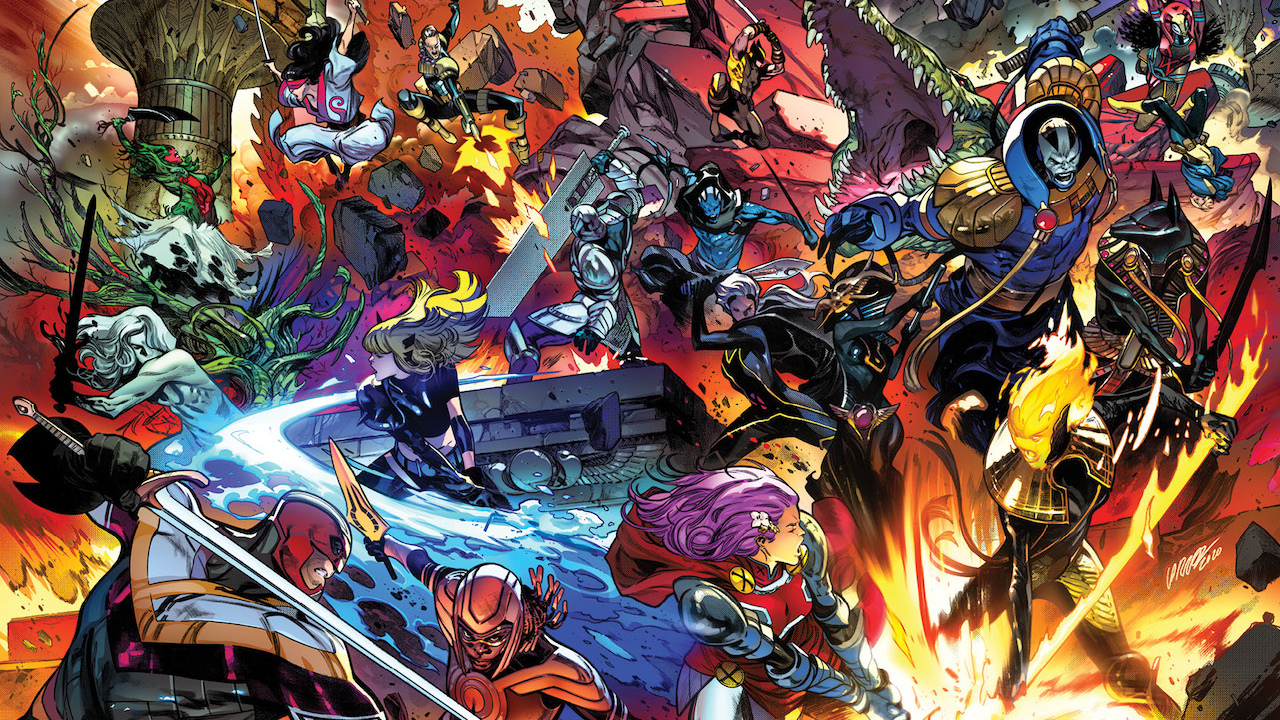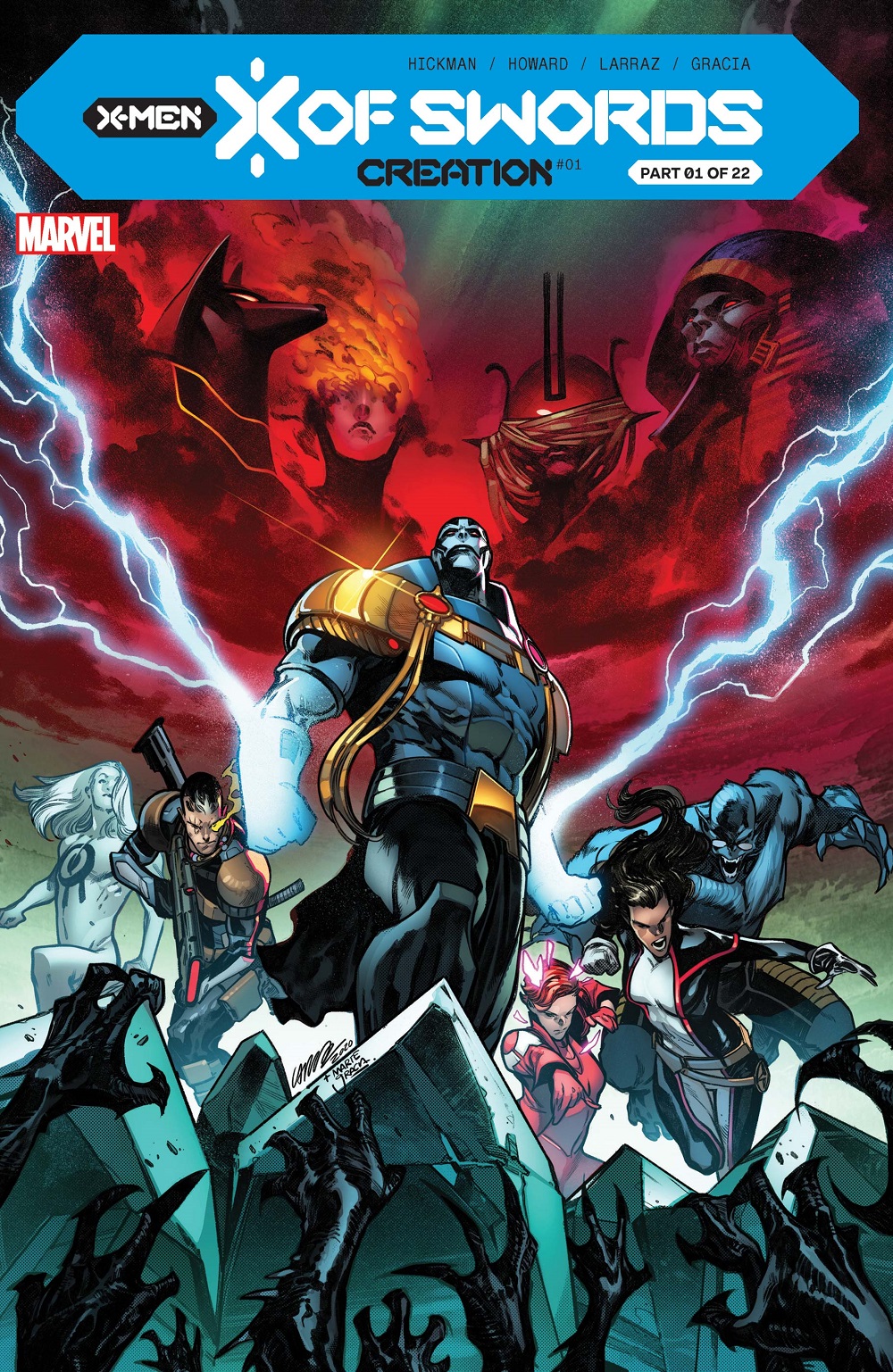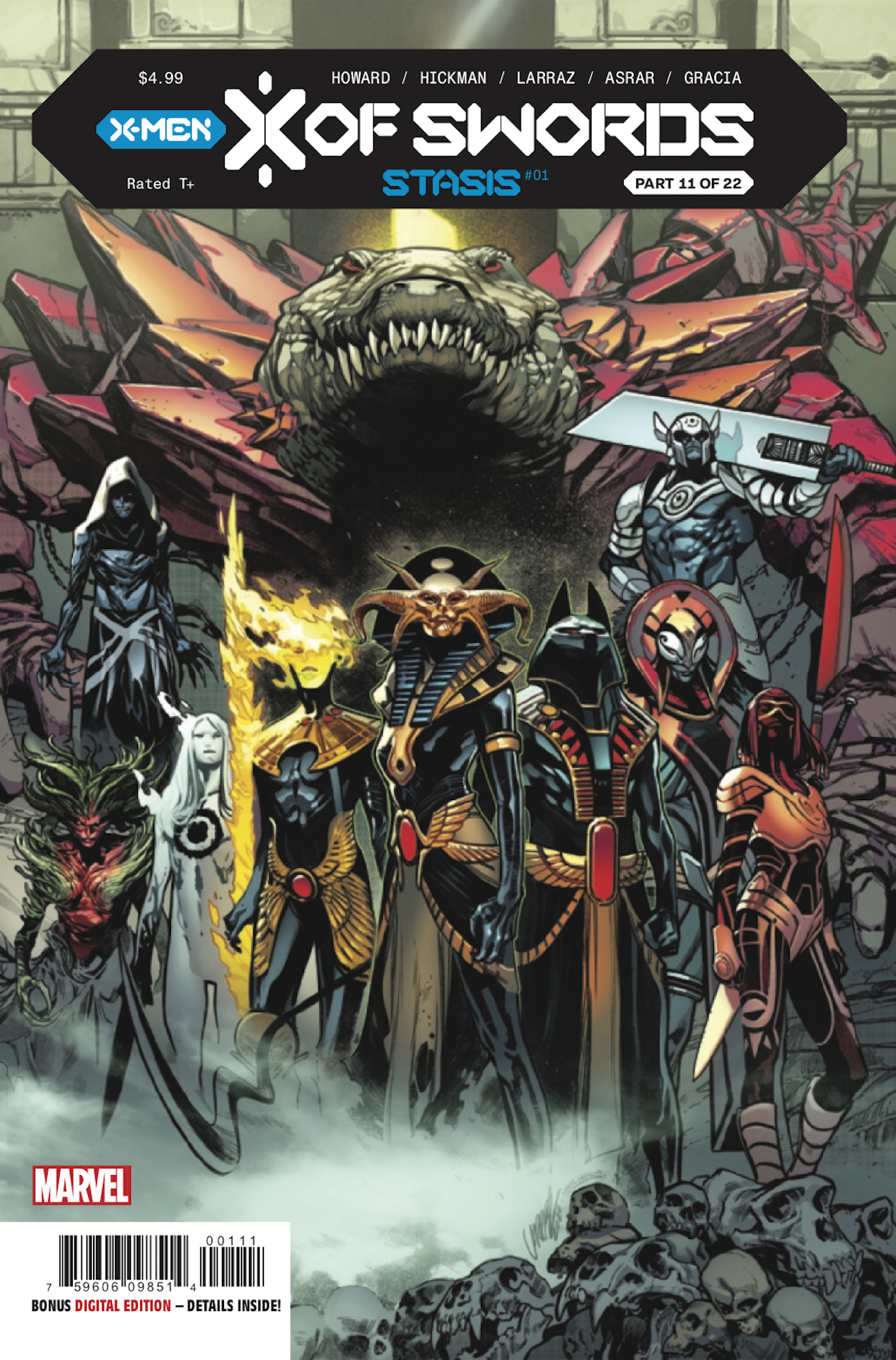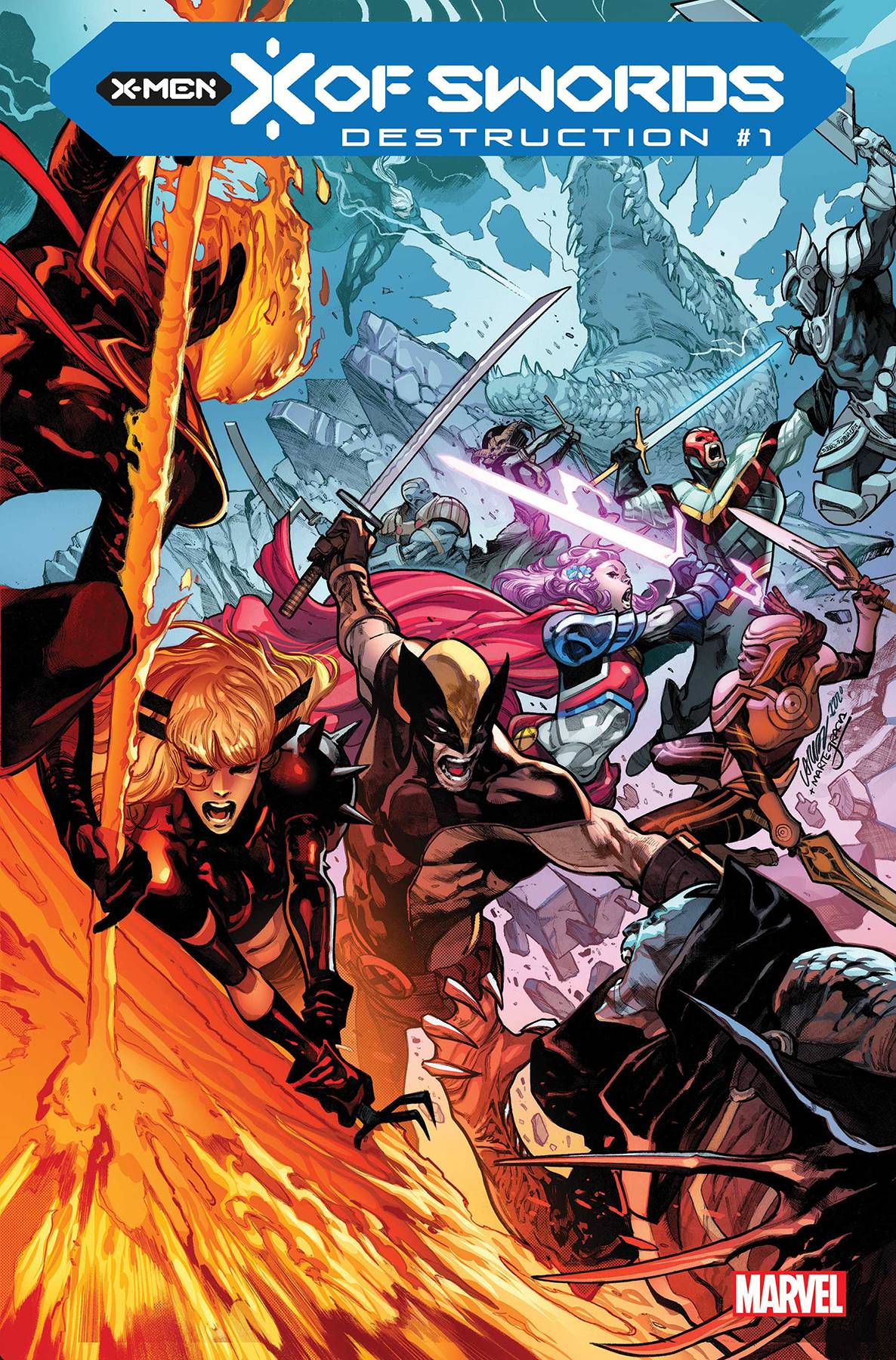Best Shots mega review: X of Swords crossover "opens up new stories and dynamics" for the X-Men line
The 'X of Swords' X-Men crossover gets a deep dive review

The first phase of the newly revitalized X-Men line – also known as 'Dawn of X' – has contributed to an overall portrait of Krakoan life, though it was still possible to pick and choose the titles that appeal the most, all of which feel different due to their individual and particular tones. Some readers would have already been following everything, but 'X of Swords' saw the various series converge to tell one big story and ask everyone to do so for a couple of months.
Written by Jonathan Hickman, Tini Howard, Leah Williams, Benjamin Percy, Vita Ayala, Zeb Wells, Ed Brisson and Gerry Duggan
Art by Marcus To, Erick Arciniega, Leinil Francis Yu, Sunny Gho, Pepe Larraz, Marte Gracia, Carlos Gomes, Israel Silva, Viktor Bogdanovic, Matthew Wilson, Matteo Lolli, Edgar Delgado, Carmen Carnero, David Curiel, Rod Reis, Phil Noto, R.B. Silva, Nolan Woodard, Mahmud Asrar, Stefano Caselli, Joshua Cassara, Guru-eFX and Rachelle Rosenberg
Lettered by Ariana Maher, Clayton Cowles, Joe Caramagna, Cory Petit, Travis Lanham and Joe Sabino
Design by Tom Muller
Published by Marvel Comics
'Rama Rating: 8 out of 10
Of course, the massive crossovers always advertise that you need to read everything to get the full story. In the case of this one, it comes pretty darn close to wholly true (aside from a couple of issues that serve as more of a side story rather than part of the main attraction) in addition to being a case study of how well the multitude of styles would mesh together.
The end result is one of two halves, a factor true of both its overall content and structure. Though before getting to the crossover itself, it is important to note the books it is springing forth from. The first part comes from Jonathan Hickman and Leinil Francis Yu's X-Men, the mainline book, which has contained tales of the land Okkara, which was once whole before being split into Krakoa and Arakko. While over in the Tini Howard-penned Excalibur, the creative team plunged headfirst into the realm of Otherworld getting involved with Omniversal Majestrix Saturnyne along the way.
What connects these two stories is the involvement of Apocalypse, or •┤Ȧ├• (an approximation of his Krakoan name). As one of the earliest mutants, he has ancient history with some of those who now call Arakko home, with his present-day machinations in Excalibur being focused around how to connect that place and his current home once again. He doesn't solely occupy the spotlight in 'X of Swords'; however, its biggest beats do a lot to reconfigure his character in a fascinating way.

Issue twelve of each series serves as a prelude to the main event – as such they're included in the collection edition – which gets properly underway with the Creation one-shot, co-written by Hickman and Howard, while Pepe Larraz and Marte Gracia handle art duties and lettered by Clayton Cowles. The scale is evident from the first page, as two battling armies duke it out, like a hybrid of an earlier Hickman event, Infinity, and his creator-owned East of West.
High above, Saturnyne watches and plans for a great game, setting up what appears to be a tournament arc between the chosen champions of Krakoa (who stand for the kingdom of Avalon) and Arakko. This is immediately followed up by X-Factor #4 from Leah Williams, Carlos Gomez, Israel Silva, and Joe Caramagna, which introduces a wrinkle into the now-accepted resurrection protocols of island life, injecting a new level of stakes into the competition.
The bulk of the crossover's first half is devoted to the fetch quests that various mutants set off on in order to take up arms – Magik is the first to ready herself, her blade already by her side – and this is where the tonal variance of the line shines the most. The overarching structure means that despite this being a succession of issues all built around similarly structured stories, the journey that each writer takes en route to this destination keeps things lively.
Comic deals, prizes and latest news
Get the best comic news, insights, opinions, analysis and more!
It should be noted that the number of parts involved in this crossover grew between its initial announcement and actual release. What was initially fifteen became twenty-two (plus the two preludes) and though the crossover never falls into a pattern of spinning its wheels, there's still some fat that could be trimmed despite the overall sense of forward momentum. Case in point, Wolverine #6 and X-Force #13 are a two-part search that could've easily been one in terms of Benjamin Percy's plotting. While this gives Solem, a new character who's presented as Wolverine's Arakkoan rival, some more space to flesh out their admittedly fun dynamic, it stands out when immediately followed up by single issues that pack just as much character, if not more, into their narratives.

Such early highlights are Marauders #13, easily the best Storm-focused issue in years, and New Mutants #13, wherein Ed Brisson takes his leave from the series, but not before writing his strongest contribution to the franchise in the form of a Doug Ramsey character study. The former comes from Vita Ayala, Matteo Lolli, Edgar Delgado, and Cory Petit and sees Ororo travel to Wakanda in order to claim the Stormbreaker sword, a trickier proposition now than it would've been if she were still married to T'Challa. The issue builds not just on this aspect of his history, but all the various stages and soars thanks to Lolli and Delgado's clear linework, sharp staging, and luminous coloring. The latter is drawn by Rod Reis, a singular artist whose soft coloring and knack for expression sell the natural connection Doug shares with the island in addition to how the stakes of the situation at hand weigh on him.
The middle of the crossover, the Stasis one-shot (from the same team as Creation and the concluding Destruction) offers a mirror to Krakoa and its swordbearers by running the clock back in order to introduce the Arakkoans who take up arms, such as Pogg Ur-Pogg, a giant crocodile with multiple arms. Larraz and Gracia use one page, in particular, to directly illustrate this symbolism.
Moments like this from the pair, as well as art in other issues courtesy of creators like Reis, Phil Noto, Joshua Cassara, and Guru-eFX also goes to show the tonal variance of the line still has a way of being cohesive. Cassara's work has a greater number of lines than Noto's lighter touch, not to mention having a more realistic color palette by way of Guru-eFX yet jumping between these styles as the story moves from book to book doesn't create a dissonance in the way a fill-in artist usually can on an event book. All of the styles depicted across 'X of Swords' feel modern and dynamic.
With the teams assembled, the second half brings them together in Otherworld and Saturnyne's game gets underway, albeit not in the way that it was first proposed. She's got more than a few tricks up her sleeve and the playfulness does end up making for a less structurally sound second-half. The narrative swerves that stem from this make it evident how much the X-writers are delighting in the fun of them and how they are coupled to the two sides' interactions.
However, the consistent zigs instead of the expected zags do lead to some of the more serious events not landing with as much weight as they could have due to a sense of being unsure if they are what they seem to be. One particular Captain Britain moment stands out in this regard, as there is little time for its impact to set in before the plotting heads off to the next event. While this matches how her Krakoan counterparts feel in the immediate aftermath, it still requires a moment for a reader's expectations to reorient themselves away from what the opening chapter of the crossover suggested.
The pacing also falters in a more apparent fashion. In the first half, Hellions #5 from Zeb Wells, Carmen Carnero, David Curiel, and Ariana Maher suggested a jaunty side-story that Hellions #6 reveals as more directly related to the series' ongoing plot over the crossover's escalation of events. For existing readers, the issues maintain the perversely delightful tone that warrants comparisons to the John Ostrander and Kim Yale-written Suicide Squad as the opening arc of the series did, though readers coming to the series by way of 'X of Swords' might find it more diverting.

Meanwhile, X-Men #14 is a remix issue. Reusing art from Yu, Mahmud Asrar, and Sunny Gho, it offers alternate narration that attempts to offer another alternate perspective but does so in such close proximity to #12, where much of the art was first utilized, and so some moments come across as a direct retread and threatens the wheel-spinning that much of the crossover's momentum resists falling prey to.
Overall, the collaborating creators do a strong job of keeping an eye on the many spinning plates from issue to issue.
Some take more prominence than is preferable, namely Wolverine, who is ostensibly the focal figure of both Marauders #14 and #15 – which luxuriate in a feast – as well as Wolverine #7 and X-Force #14 – more tournament focused. While expected due to the popularity of the character, it still frustrates considering his character is more static in terms of change and evolution compared to others in the cast. One such character is Doug, who gets a surprising swerve of a story, yet it ends up being one of the twists that work best because the writers weave its ramifications through the following issues, all the way through to the grand climax of Destruction.
All of this is to say that 'X of Swords' works much more than it doesn't, all the more impressive due to the sheer nature and length of its collaborative efforts that are practically bursting at the seams with everything it attempts. As such, there should be more than enough to delight those who can get on the majority of its wavelength. Looking at the big picture, it is respectable that everyone involved attempted to do something fresher and unpredictable instead of something which could have been simpler albeit with a blander personality.
That feels in keeping with the big swings that House of X and Powers of X took to set up this new era, and in the end, Hickman and Howard are sure enough to dial in on 'X of Swords'' most emotional aspects and deliver on these. They ensure that they don't get lost amidst the scale as well as being moments that allow for new stories and dynamics as the line heads into 'Reign of X.'
You don't need mutant powers to keep up to speed on what all the new X-Men books are. Check out our list of all the new X-Men comics, graphic novels, and collections.
Matt Sibley is a comics critic with Best Shots at Newsarama, who has contributed to the site for many years. Since 2016 in fact.


